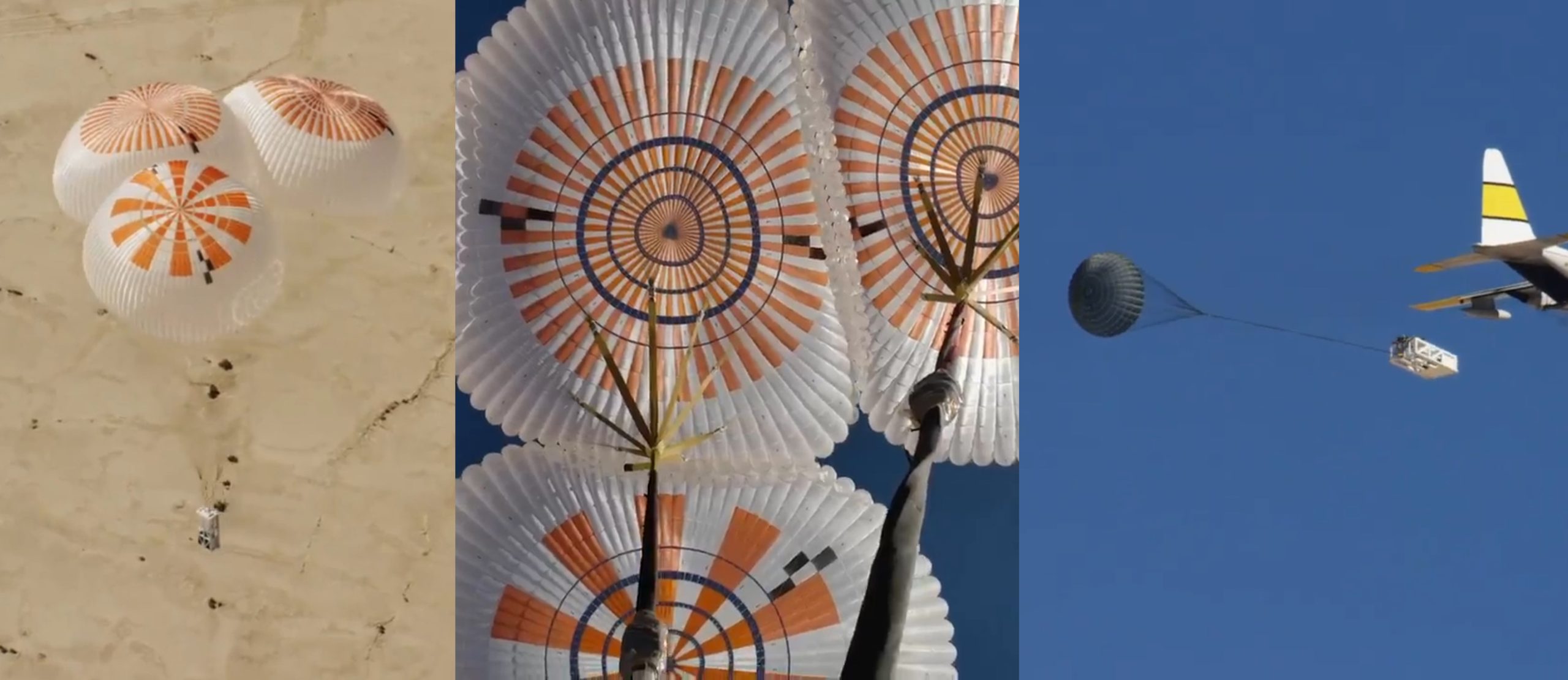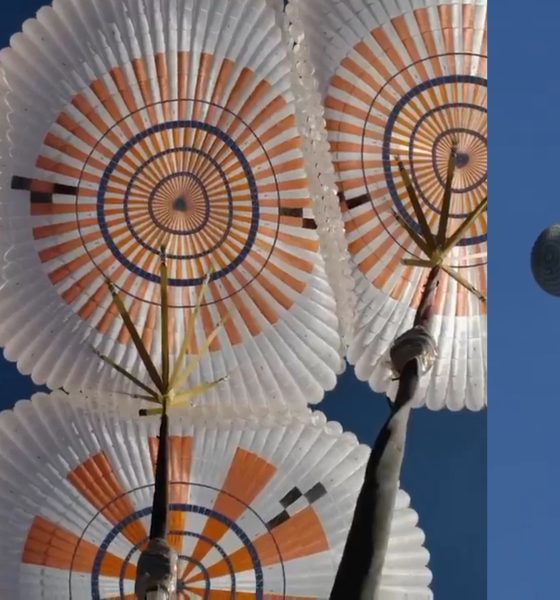

News
SpaceX says Crew Dragon parachute upgrade nailed more than a dozen tests in a row
According to SpaceX, Crew Dragon’s upgraded ‘Mk3’ parachutes have successfully completed more than a dozen tests in a row, a feat accomplished by SpaceX engineers and technicians in a single week.
Although SpaceX will likely continue to test the upgraded parachutes over the next several weeks and months, Mk3’s success up to now – including a demonstration of an emergency landing scenario – likely means that the company is well on track for NASA to certify Crew Dragon for its first astronaut launch.
Known as Demo-2, SpaceX’s first crewed demonstration mission is tentatively scheduled to launch no earlier than the first quarter of 2020 and is almost entirely dependent upon NASA (and SpaceX, to a lesser extent) completing review and qualification paperwork. On October 8th, SpaceX CEO Elon Musk indicated that SpaceX itself – including all Crew Dragon and Falcon 9 hardware – would likely be ready to launch before the end of December 2019.

During an October 30th briefing from Commercial Crew Program manager Kathy Lueders, NASA essentially confirmed Musk’s estimate for Crew Dragon hardware readiness, estimating that the Crew Dragon Demo-2 spacecraft will be ready for flight around the end of December. The mission’s Falcon 9 booster has also completed testing in Texas, while SpaceX plans to ship the Falcon 9 upper stage to Texas for acceptance testing in November.
In recent months, NASA has indicated that the parachute systems of both Boeing’s Starliner and SpaceX’s Crew Dragon were a prominent concern after chute failures occurred on several occasions. In response, SpaceX redesigned Crew Dragon’s parachutes – supplied by Airborne Systems – to account for the failure modes experience, while also advancing the state of the art of computer modeling of parachute deployment and behavior.
In response to past failures, SpaceX chose to further upgrade and strengthen Crew Dragon’s parachutes, moving to a ‘Mk3’ variant with stronger Zylon risers (strips connecting Dragon to its parachute rigging), among other tweaks. Notably, in an October 2019 press conference with Musk, NASA administrator Jim Bridenstine noted that SpaceX had plans to field and test those Mk3 parachutes at least 10 times before the end of 2019.
“We could see as many as 10 drop tests between now and the end of the year and depending on how the next 10 drop tests go, we will know how many more drops tests we are going to add.”
Jim Bridenstine, October 10th, 2019
In fact, during the latest stage of testing, SpaceX says it successfully completed thirteen consecutive tests of Crew Dragon’s new Mk3 parachutes, all of which were completed in less than two weeks. This essentially blows Bridenstine’s expectations out of the water, as SpaceX has surpassed his predicted 10 tests and done so barely three weeks into the tentative 12-week window he set. SpaceX now has plenty of time to either continue testing Crew Dragon’s parachutes or refocus its efforts on other equally important qualification challenges.
Prior to those thirteen consecutive successes, SpaceX suffered two failures during single-parachute Mk3 testing. The first two development tests of the Mk 3 design used loads much higher than the parachutes would ever see in operation in an effort to better understand overall design margins and system performance. After a period of rapid iteration with parachute provider Airborne Systems, the faults responsible for those two stress-test failures were resolved and subsequent drop tests confirmed that Mk3’s suspension lines – the numerous lines connecting the parachute to Crew Dragon – are far stronger than those on Mk2.
Perhaps most crucially, the most recent test – shown in the video shared by SpaceX on November 3rd – was the first multi-chute Mk3 demonstration and simultaneously proved that Crew Dragon will be able to safely land its astronaut passengers even if one of the spacecraft’s four parachutes fail to deploy. Despite those consecutive successes, SpaceX and Airborne will continue testing Mk3 parachutes as rapidly as possible and aim to provide NASA the data it needs to qualify Crew Dragon’s parachutes for crewed flight before the end of 2019.
Either way, the next several months are set to be a frenetic period for NASA’s Commercial Crew Program. As early as November 4th, Boeing aims to attempt a pad abort test of its Starliner spacecraft, while SpaceX is set to static fire a Crew Dragon capsule on November 6th. If both tests are successful, SpaceX aims to launch Crew Dragon’s In-Flight Abort (IFA) test in early-December, while Boeing hopes to launch Starliner on its first uncrewed Orbital Flight Test (OFT) no earlier than December 17th.
Check out Teslarati’s Marketplace! We offer Tesla accessories, including for the Tesla Cybertruck and Tesla Model 3.

Elon Musk
SpaceX issues statement on Starship V3 Booster 18 anomaly
The incident unfolded during gas-system pressure testing at the company’s Massey facility in Starbase, Texas.

SpaceX has issued an initial statement about Starship Booster 18’s anomaly early Friday. The incident unfolded during gas-system pressure testing at the company’s Massey facility in Starbase, Texas.
SpaceX’s initial comment
As per SpaceX in a post on its official account on social media platform X, Booster 18 was undergoing gas system pressure tests when the anomaly happened. Despite the nature of the incident, the company emphasized that no propellant was loaded, no engines were installed, and personnel were kept at a safe distance from the booster, resulting in zero injuries.
“Booster 18 suffered an anomaly during gas system pressure testing that we were conducting in advance of structural proof testing. No propellant was on the vehicle, and engines were not yet installed. The teams need time to investigate before we are confident of the cause. No one was injured as we maintain a safe distance for personnel during this type of testing. The site remains clear and we are working plans to safely reenter the site,” SpaceX wrote in its post on X.
Incident and aftermath
Livestream footage from LabPadre showed Booster 18’s lower half crumpling around the liquid oxygen tank area at approximately 4:04 a.m. CT. Subsequent images posted by on-site observers revealed extensive deformation across the booster’s lower structure. Needless to say, spaceflight observers have noted that Booster 18 would likely be a complete loss due to its anomaly.
Booster 18 had rolled out only a day earlier and was one of the first vehicles in the Starship V3 program. The V3 series incorporates structural reinforcements and reliability upgrades intended to prepare Starship for rapid-reuse testing and eventual tower-catch operations. Elon Musk has been optimistic about Starship V3, previously noting on X that the spacecraft might be able to complete initial missions to Mars.
Investor's Corner
Tesla analyst maintains $500 PT, says FSD drives better than humans now
The team also met with Tesla leaders for more than an hour to discuss autonomy, chip development, and upcoming deployment plans.

Tesla (NASDAQ:TSLA) received fresh support from Piper Sandler this week after analysts toured the Fremont Factory and tested the company’s latest Full Self-Driving software. The firm reaffirmed its $500 price target, stating that FSD V14 delivered a notably smooth robotaxi demonstration and may already perform at levels comparable to, if not better than, average human drivers.
The team also met with Tesla leaders for more than an hour to discuss autonomy, chip development, and upcoming deployment plans.
Analysts highlight autonomy progress
During more than 75 minutes of focused discussions, analysts reportedly focused on FSD v14’s updates. Piper Sandler’s team pointed to meaningful strides in perception, object handling, and overall ride smoothness during the robotaxi demo.
The visit also included discussions on updates to Tesla’s in-house chip initiatives, its Optimus program, and the growth of the company’s battery storage business. Analysts noted that Tesla continues refining cost structures and capital expenditure expectations, which are key elements in future margin recovery, as noted in a Yahoo Finance report.
Analyst Alexander Potter noted that “we think FSD is a truly impressive product that is (probably) already better at driving than the average American.” This conclusion was strengthened by what he described as a “flawless robotaxi ride to the hotel.”
Street targets diverge on TSLA
While Piper Sandler stands by its $500 target, it is not the highest estimate on the Street. Wedbush, for one, has a $600 per share price target for TSLA stock.
Other institutions have also weighed in on TSLA stock as of late. HSBC reiterated a Reduce rating with a $131 target, citing a gap between earnings fundamentals and the company’s market value. By contrast, TD Cowen maintained a Buy rating and a $509 target, pointing to strong autonomous driving demonstrations in Austin and the pace of software-driven improvements.
Stifel analysts also lifted their price target for Tesla to $508 per share over the company’s ongoing robotaxi and FSD programs.
Elon Musk
SpaceX Starship Version 3 booster crumples in early testing
Photos of the incident’s aftermath suggest that Booster 18 will likely be retired.

SpaceX’s new Starship first-stage booster, Booster 18, suffered major damage early Friday during its first round of testing in Starbase, Texas, just one day after rolling out of the factory.
Based on videos of the incident, the lower section of the rocket booster appeared to crumple during a pressurization test. Photos of the incident’s aftermath suggest that Booster 18 will likely be retired.
Booster test failure
SpaceX began structural and propellant-system verification tests on Booster 18 Thursday night at the Massey’s Test Site, only a few miles from Starbase’s production facilities, as noted in an Ars Technica report. At 4:04 a.m. CT on Friday, a livestream from LabPadre Space captured the booster’s lower half experiencing a sudden destructive event around its liquid oxygen tank section. Post-incident images, shared on X by @StarshipGazer, showed notable deformation in the booster’s lower structure.
Neither SpaceX nor Elon Musk had commented as of Friday morning, but the vehicle’s condition suggests it is likely a complete loss. This is quite unfortunate, as Booster 18 is already part of the Starship V3 program, which includes design fixes and upgrades intended to improve reliability. While SpaceX maintains a rather rapid Starship production line in Starbase, Booster 18 was generally expected to validate the improvements implemented in the V3 program.
Tight deadlines
SpaceX needs Starship boosters and upper stages to begin demonstrating rapid reuse, tower catches, and early operational Starlink missions over the next two years. More critically, NASA’s Artemis program depends on an on-orbit refueling test in the second half of 2026, a requirement for the vehicle’s expected crewed lunar landing around 2028.
While SpaceX is known for diagnosing failures quickly and returning to testing at unmatched speed, losing the newest-generation booster at the very start of its campaign highlights the immense challenge involved in scaling Starship into a reliable, high-cadence launch system. SpaceX, however, is known for getting things done quickly, so it would not be a surprise if the company manages to figure out what happened to Booster 18 in the near future.








